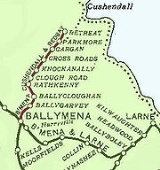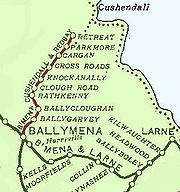
Ballymena, Cushendall and Red Bay Railway
Encyclopedia
The Ballymena, Cushendall and Red Bay Railway was a narrow gauge railway between Ballymena
and Retreat, both in County Antrim
, in what is now Northern Ireland
. It operated from 1875 to 1940.
 The railway line was incorporated in 1872, opened in May 1875 and was the first narrow gauge railway in Ireland
The railway line was incorporated in 1872, opened in May 1875 and was the first narrow gauge railway in Ireland
to be sanctioned by Parliament. It was essentially a mineral railway which ran for 16¼ miles from Ballymena to Retreat. It served iron mines in the area, which were connected to the mainline by sidings
and branch lines, some of which were owned by mining companies. Initially it was financially successful, but later the market collapsed and in October 1884 it was taken over by the Belfast and Northern Counties Railway (BNCR), the sale having being approved by Parliament on 14 July 1884. In 1886 the first passenger trains were introduced, which terminated at Parkmore, some 2¾ miles from Retreat.
For most of the route from Ballymena trains had to struggle against the gradient taking 50 minutes for the northbound journey and returning in 40 minutes. The summit at Essathohan siding was 1045 feet (318.5 m) above sea level, the highest point reached by an Irish railway. To reach the tourist areas of Cushendall
and Glenariff
, passengers had to hire road transport from the Parkmore terminus. At the start three Black Hawthorn
0-4-2ST engines were used, but these were replaced by the BNCR. Passengers were transported in tramway type bogie carriages. Passenger traffic ceased in 1930 and goods traffic ceased in 1940.
Ballymena
Ballymena is a large town in County Antrim, Northern Ireland and the seat of Ballymena Borough Council. Ballymena had a population of 28,717 people in the 2001 Census....
and Retreat, both in County Antrim
County Antrim
County Antrim is one of six counties that form Northern Ireland, situated in the north-east of the island of Ireland. Adjoined to the north-east shore of Lough Neagh, the county covers an area of 2,844 km², with a population of approximately 616,000...
, in what is now Northern Ireland
Northern Ireland
Northern Ireland is one of the four countries of the United Kingdom. Situated in the north-east of the island of Ireland, it shares a border with the Republic of Ireland to the south and west...
. It operated from 1875 to 1940.
History

Ireland
Ireland is an island to the northwest of continental Europe. It is the third-largest island in Europe and the twentieth-largest island on Earth...
to be sanctioned by Parliament. It was essentially a mineral railway which ran for 16¼ miles from Ballymena to Retreat. It served iron mines in the area, which were connected to the mainline by sidings
Rail siding
A siding, in rail terminology, is a low-speed track section distinct from a running line or through route such as a main line or branch line or spur. It may connect to through track or to other sidings at either end...
and branch lines, some of which were owned by mining companies. Initially it was financially successful, but later the market collapsed and in October 1884 it was taken over by the Belfast and Northern Counties Railway (BNCR), the sale having being approved by Parliament on 14 July 1884. In 1886 the first passenger trains were introduced, which terminated at Parkmore, some 2¾ miles from Retreat.
For most of the route from Ballymena trains had to struggle against the gradient taking 50 minutes for the northbound journey and returning in 40 minutes. The summit at Essathohan siding was 1045 feet (318.5 m) above sea level, the highest point reached by an Irish railway. To reach the tourist areas of Cushendall
Cushendall
Cushendall and formerly known as Newtown Glens is a village and townland in County Antrim, Northern Ireland.It is on the A2 coast road between Glenariff and Cushendun, in the Antrim Coast and Glens Area of Outstanding Natural Beauty...
and Glenariff
Glenariff
Glenariff is a glen in the County Antrim, Northern Ireland. Like all glens in that area, it was shaped during the Ice Age by giant glaciers....
, passengers had to hire road transport from the Parkmore terminus. At the start three Black Hawthorn
Black, Hawthorn & Co
Black, Hawthorn and Company was a steam locomotive manufacturer with a works situated in Gateshead, Tyne and Wear, UK.-John Coulthard and Son:...
0-4-2ST engines were used, but these were replaced by the BNCR. Passengers were transported in tramway type bogie carriages. Passenger traffic ceased in 1930 and goods traffic ceased in 1940.
Route
- Ballymena
- Ballygarvey, 2¾-miles, open for passenger traffic 01/10/1888 to final closure 01/10/1930.
- Ballycloughan, 4-miles, open for passenger traffic from 05/04/1886 to 01/10/1930, goods & final closure 03/06/1940.
- Rathkenny, 6-miles, open for passenger traffic from 05/04/1886 to 01/10/1930, goods closure 12/04/1937, final closure 03/06/1940.
- Clough Road, 6¾-miles, open for passenger traffic from 05/04/1886, goods, passenger & final closure 01/10/1930.
- Knockanally (re-named Martinstown 01/07/1920), 8¼-miles, open for passenger traffic from 05/04/1886 to 01/10/1930, goods & final closure 12/04/1937.
- Cross Roads (formerly Carrowcowan), 9¾-miles, open for passenger traffic from 01/08/1886. Goods, passenger & final closure 01/10/1930.
- CarganCarganCargan is a small village and townland in County Antrim, Northern Ireland. It lies at the foot of Slievenanee in Glenravel – locally known as "The Tenth Glen" along with the more widely known nine Glens of Antrim. In the 2001 Census it had a population of 411 people...
, 11¼-miles, open for passenger traffic from 01/06/1889 to 01/10/1930, goods closure 07/1923, final closure 12/04/1937. - Parkmore, 13½-miles, open for passenger traffic from 01/09/1888. Goods, passenger & final closure 01/10/1930.
- Retreat., 16¼-miles.
See also
- Ballycastle RailwayBallycastle RailwayBallycastle Railway was a narrow gauge railway line which ran from Ballycastle to Ballymoney, both in County Antrim, Northern Ireland.-History:...
- Ballymena and Larne RailwayBallymena and Larne RailwayThe Ballymena and Larne Railway was a narrow gauge railway in County Antrim, Northern Ireland. The first part opened in July 1877 and regular passenger services began in August 1878, the first on the three foot Irish narrow gauge...
- List of narrow gauge railways in Ireland

